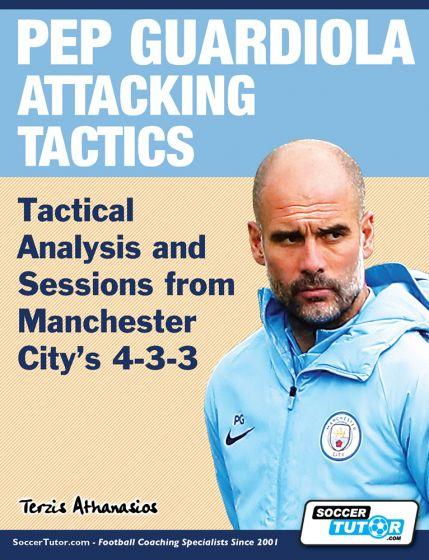The 4-3-3 formation is a widely popular and effective tactical setup in soccer, allowing teams to maintain a balanced approach between defense and attack. However, mastering this formation requires diligent training and well-thought-out soccer drills. In this article, we will explore three training drills designed to help players and teams perfect the 4 3 3 formation, maintain ball possession and improve their overall performance on the field.
Great modern coaches such as Pep Guardiola, Jurgen Klopp (under Liverpool FC), Maurizio Sarri, Xavi (former central midfielder and now head coach of Barcelona), Carlo Ancelotti, and from previous decades, Johan Cruyff and Rinus Michels, the father of Total Football, based their whole coaching philosophy around this soccer formation and its tactical adaptations.

Elevate Your Coaching Journey
Are you ready to take your coaching career to the next level? Look no further than FootballCoach365, your ultimate destination for top-notch coaching and mentoring services.
With our coaching and mentoring service, you’ll unlock a world of benefits.
Join the FootballCoach365 community today and experience the transformative power of coaching and mentoring. With our guidance, you’ll not only become a better football coach but also lead a more fulfilling professional life.
Table of Contents
PEP GUARDIOLA – 85 PASSING, RONDOS, POSSESSION GAMES & TECHNICAL CIRCUITS DIRECT FROM PEP’S TRAINING SESSIONS

Looking to take your team’s performance to the next level?
- Warm-ups (training and match day)
- Speed & Agility (without/with ball)
- Technical Circuits
- Passing
- Rondos
- Juego de Posición (Positional Games)
- Possession Games
- Attacking Positional Patterns of Play
- Small to Large Sided Games
- Taken directly from Pep’s training sessions at Manchester City, Bayern Munich and FC Barcelona.
- This is your chance to practice and apply Pep Guardiola’s training sessions to develop your players’ speed, agility, technique and positional play – a unique opportunity to improve your team’s performance using practices from the highest level.
Coaching Tips for Effective Designing of Drills
Below are some very basic coaching tips on how to design effective training drills to help the players better understand the exercise objective:
- Set Specific Objectives: Clearly define the purpose of each drill and what you want the players to achieve. Whether it’s improving passing accuracy or enhancing defensive positioning, having a specific objective will keep the players focused.
- Progressive Difficulty: Design drills that gradually increase in difficulty to challenge players as they improve. Starting with basic exercises and gradually adding complexity helps players build their skills step by step.
- Include Real-Game Scenarios: Incorporate drills that mimic real-game situations. This allows players to apply their training directly to match scenarios, making the learning experience more effective.
- Provide Feedback: Offer constructive feedback to players during and after the drills. Positive reinforcement and guidance on areas for improvement will motivate players to work harder and refine their techniques.
- Encourage Communication: Emphasize the importance of communication during drills. Encourage players to talk to each other, both on and off the ball, to enhance team cohesion and decision-making.
- Keep it Fun and Engaging: Training should be enjoyable for the players. Incorporate creative and enjoyable elements into the drills to keep the enthusiasm high and maintain player interest.
- Observe and Adapt: As a coach, closely observe how players respond to different drills. Adjust and modify the exercises if necessary to suit the team’s dynamics and individual player strengths.
PEP GUARDIOLA ATTACKING TACTICS – TACTICAL ANALYSIS AND SESSIONS FROM MANCHESTER CITY’S 4-3-3

Attacking Tactics from Manchester City’s 4-3-3
- Overcoming the Pressing of the Opposing Forwards
- Positioning and Rotations with Inverted Full Backs
- Creating and Exploiting Overloads in Wide Areas
- Attacking Options when the Overload Out Wide is Blocked
- Moving the Ball Wide and Receiving in Behind the Full Back (or Create Space for Inside Pass)
- Combination Play Out Wide when the Overload is Blocked
- Stretching the Opposition’s Defence and Switching Play
- Attacking Options when the Attacking Midfielder Receives Between the Lines
- Exploiting Space Created when the Opposing Centre Back Pushes Out to Press the Ball
- Attacking Through the Centre with the Forward Dropping Back to Receive
- Switching Play to the Weak Side when the Overload is Blocked Against the 4-3-3
- Attacking Against a Back 5
Create and Exploit Wide Areas in a 4-3-3 formation
Using a 4 3 3 formation provides the opportunity to create overloads in wide areas almost against any formation. The opponents require to shift their lines to manage to deal with these overloads leaving empty spaces for the weak side.


The two diagrams above show the two different overloads that can be created and take advantage of wide areas. At the same time, the shift of the team to one side creates space for the wide players on the weak side providing the option for a fast switch side and 1 v 1 situations.
To manage that one key point is to have players in the half spaces, between the lines that will create confusion for the defensive line, stretch the players horizontally, and at the same time pin back.

Drills main characteristics
- Drills focusing on maintaining an attacking shape and relatively close distances help players understand their roles in the backline.
- Communication exercises, such as constant verbal and visual cues, help improve teamwork and avoid defensive errors.
- Timing of movements
- Quality passing
- Proper body position and body profile for the receiving
Drill 1: Combination and Finishing
Description:
The players start on the blue cones. The yellow mannequins represent the opponents in a formation with 2 lines of 4 (such as 4 – 4 – 2).
The drill aims to train 2 different passing combinations offering two different options to find a pass around the back line of four or between the players.
For the first pattern, the drill starts from the central defender (CB) #5 who passes the ball to the defensive midfielder (DM) #6. The DM returns the ball to the CB and at the same time, the right fullback (RB) #2 makes a move to offer support and receive the ball toward the inside half space. As soon as the RB receives the ball. The attacking midfielder (AM) of the strong side, #10, makes a move toward the sideline to receive a progressive pass. The Right Winger #7, makes a fake movement to dismark following a forward run to the sideline to receive the vertical pass from #10.
To complete the drill, three players, the weak side wide player, the center forward (CF or Striker – #9), and the weak side AM #8 will make a run to the box for the finishing occupying the three dangerous areas, first post, second post, and penalty spot.
The second pattern aims to break the lines in a more vertical way. The drill starts from the same point. After the first pass, the DM will pass the ball to the full-back who comes in the half space (closer than the first pattern). At that point, the AM and RW will make fake movements. The AM will ask for the space and come to the feet and will receive a pass between the lines and the RW will make a fake movement asking to the sideline. As soon as the Am will receive the ball, the RW will make a diagonal run behind the opponent’s full-back to receive a pass. The cross at that point should be early on the ground.
The drill can work with 2 different teams working alternative both sides. It can be used to train any attacking player, advanced midfielder, or center backs and wing players to identify the proper timing to combine between them and put the ball behind the opposing team back line.
Coaching points
- Quality passes and receiving with the correct body profile
- Timing and synchronization of movements
- Quality of crosses and finishing
Progression
After the players will learn the passing patterns, the drill can have a progression by switching some mannequins with opponents to add the element of decision-making and increase the level of difficulty.
The aim is to move the ball to the winger for a cross (early or from the sideline) either by passing the ball around the defensive line or with a through ball.
Since the drill is more game-realistic, new passing combinations may appear offering more solutions to this tactical situation.
By adding the element of opponents, another important Positional Play concept may appear, the Third Man.



Switch with 2 opponents – FBs

Switch with 2 opponents – CBs
Drill 2: Triangle Passing Drills – Midfield rotation

Description
The passing drill aims to train the three midfielders how, when, and why to rotate positions during the build-up. The outside players are moving outside the box and following the pass and inside players are changing positions – Midfield rotations. The inside player defensive midfielder (#6) asks and passes back the ball. The weak side attacking midfielder (#8 in this situation) gives the signal to initiate the rotation. The #6 moves up asking for the ball, ideally creating space for the #8 to come low asking for the ball in a diagonal position.
Progression
The drill works with two balls. If the players manage to have a good rhythm a third ball can be added. To have a nice flow of the drill, add another one midfielder in each triangle.

Drill 3: Positional Game – Play through the central channel

Description
Positional Game 7 v 7 + 2 neutrals. The objective is for the team in possession to transfer the ball from one side to the other. The defenders should recover the ball, pass to one neutral, and switch positions (become attackers). The team in possession should try to always have a specific attacking formation to ensure attacking width and depth. The should have 2 wide players on each side and three in the central area.
Train the players to keep short distances between them and try to attack as a block. This will help them to have a fast and effective reaction during the defensive transition.
Rules
- Each time the ball goes from one side to the other = 1 goal
- If the ball pass throug hthe central ball and goes to the other side = 2 goals
- The neutrals cannot pass to the other side neutral directly
- When the pass is transfer from Z1 to Z2 and goes to the neutral, the 1st pass must be inside the zone.
- The wide players should be two in each zone (Z1 and Z2)
- Inside the SZ1 and SZ2, when the ball is on the respective Z1 or Z2, maximum one player can there. For example, if the ball on the neutral inside Z1, maximum one attacker can be inside SZ1. This is to help the attackers maintain their structure with one defensive midfielder.
FAQs
- What are the advantages of the 4-3-3 formation?
- The 4-3-3 formation offers a balanced approach between defense and attack, with a solid midfield base and potent attacking options.
- Can any team play the 4-3-3 formation?
- While the 4-3-3 formation suits many teams, its success depends on the players’ skill set and the tactical approach of the coach.
- How long does it take for a team to adapt to the 4-3-3 formation?
- The adaptation period varies, but consistent training and practice can hasten the process of becoming proficient in the formation.
- Are there variations of the 4-3-3 formation?
- Yes, some variations involve pushing the wingers higher up the pitch or using a false nine instead of a traditional center forward.
- Can youth teams benefit from the 4-3-3 formation?
- Absolutely! The 4-3-3 formation encourages player development and improves team dynamics, making it suitable for youth soccer as well.

